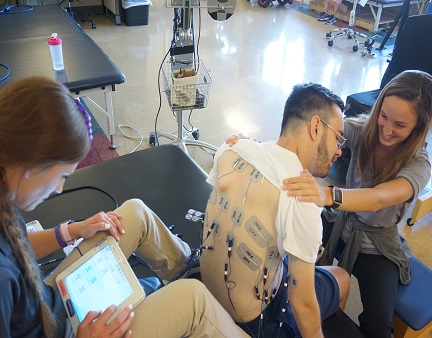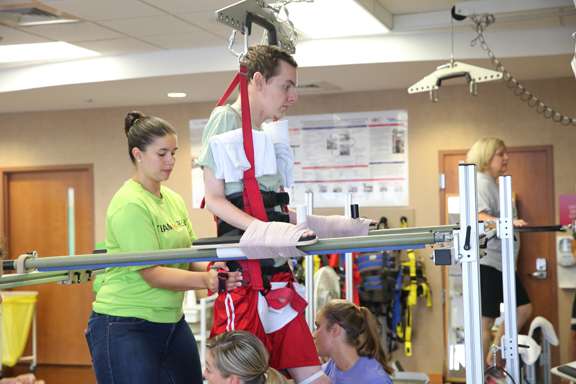Stand Training
During stand training sessions, participants may use a custom-designed standing apparatus or a less assistive device such as a walker or cane. In case of arm and/or trunk control inefficiencies that cannot be overcome with manual facilitation only, participants will stand on a treadmill in a harness attached to a body weight support system. The level of manual facilitation provided by the activity based training team and the level of body weight support for those trained on the treadmill will be reduced continuously over the course of the training sessions as individuals increase their ability to bear weight on their legs and to segmentally control their posture (e.g. trunk, hips, knees, ankles). Participants are encouraged to stand for as long as possible throughout the training session, with the goal to stand for 60 minutes or more with the least amount of assistance from the training team, body weight support system, and/or standing apparatuses. Depending upon study enrollment, sessions can occur one to three times daily, five days per week. Dynamic standing exercises (e.g. shifting to the left and right, shifting forward and backward, and squatting) are completed throughout the full training session between bouts of static standing with the best posture as possible.
 Stand Training with Neuromuscular Electrical Stimulation Stand Training with Neuromuscular Electrical Stimulation
Sessions with Neuromuscular Electrical Stimulation (NMES) include the same kind of stand training as described above with the addition of electrical stimulation provided through self-adhesive pads over the muscles of the legs to contract these muscles and increase the central state of excitability of the nervous system. The parameters and patterns of stimulation are dependent upon study enrollment and the force produced through NMES found during pre-training assessments.
 NMES of the Legs NMES of the Legs
During lower extremity NMES sessions, participants receive electrical stimulation to contract the muscles of the legs and increase the central state of excitability of the nervous system. The stimulation is provided while participants are lying down or seated, depending upon study enrollment. The parameters and patterns of the stimulation are dependent upon the study and the force produced through NMES found during pre-training assessments. Stimulation of the trunk muscles and/or legs may be done with lower extremity NMES. Sessions are 60 minutes or more and may be done multiple times per day.
 NMES of the Arms NMES of the Arms
During upper extremity NMES sessions, participants receive electrical stimulation to contract the muscles of the arms and increase the central state of excitability of the nervous system. Stimulation is also sometimes provided over the spinal cord over the level associated with arm function. The stimulation is provided while participants are seated or standing, depending upon study enrollment. The parameters and patterns of the stimulation are dependent upon the study and the force produced through NMES found during pre-training assessments. Individuals engage in functional movements and exercises (e.g. forward reaching, grasping) during stimulation sessions. Stimulation of the trunk muscles and/or legs may be done with upper extremity NMES. Sessions are 60 minutes or more and may be done multiple times per day.
NMES of the Trunk
During trunk NMES sessions, participants receive electrical stimulation to contract the muscles of the trunk and increase the central state of excitability of the nervous system. The stimulation is provided while participants are seated or standing, depending upon study enrollment. The parameters and patterns of the stimulation are dependent upon the study and the force produced through NMES found during pre-training assessments. Individuals engage in functional movements and exercises (e.g. forward reaching, grasping) during stimulation sessions. Stimulation of the muscles of the arms and/or legs may be done with trunk NMES. Sessions are 60 minutes or more and may be done multiple times per day.
Arm Crank
During arm crank sessions, participants receive a non-weight bearing, task specific intervention using a SCI-FIT arm cycle ergometer. Sessions are designed to safely provide activity to achieve a cardiovascular response and gradually increase cycle duration, endurance and level of resistance. Hand wraps are used for participants having difficulty grasping the cycle handles. Proper positioning and arm kinematics are assessed to assure the participant is in the most optimal state to receive the intervention. Sessions can vary from 30 to 60 minutes depending on the participant’s progression. This intervention is conducted 5 days per week.
|
Adult NeuroRecovery Program
Neuromuscular Electrical Stimulation
Muscle Oxidation
Urogenital
Translational Research at KSCIRC
Translational Science Cores
Translational Support Cores
Clinical Trials
NACTN
ClinicalTrials.gov
|








